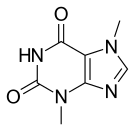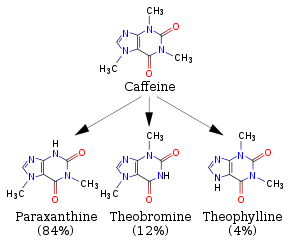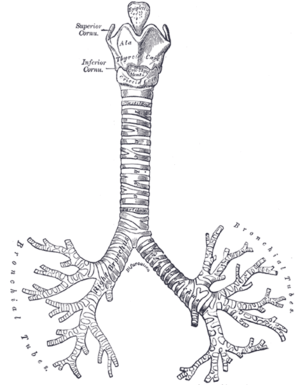Theobromine
 | |
 | |
| Clinical data | |
|---|---|
| Synonyms |
xantheose diurobromine 3,7-dimethylxanthine |
| Routes of administration | Oral |
| ATC code | |
| Legal status | |
| Legal status |
|
| Pharmacokinetic data | |
| Metabolism | Hepatic demethylation and oxidation |
| Elimination half-life | 7.1±0.7 hours |
| Excretion | Renal (10% unchanged, rest as metabolites) |
| Identifiers | |
| |
| CAS Number | |
| PubChem CID | |
| DrugBank | |
| ChemSpider | |
| UNII | |
| KEGG | |
| ChEBI | |
| ChEMBL | |
| ECHA InfoCard |
100.001.359 |
| Chemical and physical data | |
| Formula | C7H8N4O2 |
| Molar mass | 180.164 g/mol |
| 3D model (JSmol) | |
| |
| |
| (verify) | |
Theobromine, formerly known as xantheose,[1] is a bitter alkaloid of the cacao plant, with the chemical formula C7H8N4O2.[1] It is found in chocolate, as well as in a number of other foods, including the leaves of the tea plant, and the kola nut. It is classified as a xanthine alkaloid,[2] others of which include theophylline and caffeine.[1] The compounds differ in that caffeine has an extra methyl group (see under Pharmacology section).
Despite its name, the compound contains no bromine—theobromine is derived from Theobroma, the name of the genus of the cacao tree (which itself is made up of the Greek roots theo ("god") and broma ("food"), meaning "food of the gods"[3]) with the suffix -ine given to alkaloids and other basic nitrogen-containing compounds.[4]
Theobromine is a slightly water-soluble (330 mg/L[5]), crystalline, bitter powder. Theobromine is white or colourless, but commercial samples can be yellowish.[6] It has an effect similar to, but lesser than, that of caffeine in the human nervous system, making it a lesser homologue. Theobromine is an isomer of theophylline, as well as paraxanthine. Theobromine is categorized as a dimethyl xanthine.[7]
Theobromine was first discovered in 1841[8] in cacao beans by Russian chemist Alexander Voskresensky.[9] Synthesis of theobromine from xanthine was first reported in 1882 by Hermann Emil Fischer.[10][11]
Sources
Theobromine is the primary alkaloid found in cocoa and chocolate. Cocoa powder can vary in the amount of theobromine, from 2%[12] theobromine, up to higher levels around 10%. There are usually higher concentrations in dark than in milk chocolate.[13] Theobromine can also be found in small amounts in the kola nut (1.0–2.5%), the guarana berry, yerba mate (Ilex paraguariensis), and the tea plant.[14] 28 grams (1 oz) of milk chocolate contains approximately 60 milligrams (1 grain) of theobromine,[15] while the same amount of dark chocolate contains about 200 milligrams (3 grains).[16] Cocoa beans naturally contain approximately 1% theobromine.[17]
The plant species with the largest amounts of theobromine are:[18]
- Theobroma cacao
- Theobroma bicolor
- Ilex paraguariensis
- Ilex guayusa
- Camellia sinensis
- Cola acuminata
- Theobroma angustifolium
- Guarana
- Coffea arabica
The mean theobromine concentrations in cocoa and carob products are:[19]

| Item | Mean theobromine content ratio (10−3) |
|---|---|
| Cocoa | 20.3 |
| Cocoa cereals | 0.695 |
| Chocolate bakery products | 1.47 |
| Chocolate toppings | 1.95 |
| Cocoa beverages | 2.66 |
| Chocolate ice creams | 0.621 |
| Chocolate milks | 0.226 |
| Carob products | 0.000–0.504 |
Biosynthesis
Theobromine is a purine alkaloid derived from xanthosine, a nucleoside. Cleavage of the ribose and N-methylation yields 7-methylxanthosine. 7-Methylxanthosine in turn is the precursor to theobromine, which in turn is the precursor to caffeine.[20]
Pharmacology

Even without dietary intake, theobromine may occur in the body as it is a product of the human metabolism of caffeine, which is metabolised in the liver into 12% theobromine, 4% theophylline, and 84% paraxanthine.[21]
In the liver, theobromine is metabolized into xanthine and subsequently into methyluric acid.[22] Important enzymes include CYP1A2 and CYP2E1.[23]
Like other methylated xanthine derivatives, theobromine is both a:
- competitive nonselective phosphodiesterase inhibitor,[24] which raises intracellular cAMP, activates PKA, inhibits TNF-alpha[25][26] and leukotriene[27] synthesis, and reduces inflammation and innate immunity[27] and
- nonselective adenosine receptor antagonist.[28]
As a phosphodiesterase inhibitor, theobromine prevents the phosphodiesterase enzymes from converting the active cAMP to an inactive form.[29] cAMP works as a second messenger in many hormone- and neurotransmitter-controlled metabolic systems, such as the breakdown of glycogen. When the inactivation of cAMP is inhibited by a compound such as theobromine, the effects of the neurotransmitter or hormone that stimulated the production of cAMP are much longer-lived. In general, the net result is a stimulatory effect.[30]
Effects
Theobromine is a vasodilator, a diuretic, and heart stimulant.[1] It is not currently used as a medicinal drug.[31]
Humans

The amount of theobromine found in chocolate is small enough that chocolate can, in general, be safely consumed by humans. Theobromine poisoning may result from the chronic or acute consumption of large quantities, especially in the elderly.[32] At doses of 0.8-1.5 g/day (50-100 g cocoa) sweating, trembling and severe headaches were noted. Limited mood effects were shown at 250 mg/day and negative mood effects above.[33]
Theobromine and caffeine are similar in that they are related alkaloids. Theobromine is weaker in both its inhibition of cyclic nucleotide phosphodiesterases and its antagonism of adenosine receptors.[34]
Animals
Animals that metabolize theobromine (found in chocolate) more slowly, such as dogs,[35] can succumb to theobromine poisoning from as little as 50 grams (1.8 oz) of milk chocolate for a smaller dog and 400 grams (14 oz), or around nine 44-gram (1.55 oz) small milk chocolate Hershey bars, for an average-sized dog. It should be observed the concentration of theobromine in dark chocolates (approximately 10 g/kg (0.16 oz/lb)) is up to 10 times that of milk chocolate (1 to 5 g/kg (0.016 to 0.080 oz/lb)) - meaning dark chocolate is far more toxic to dogs per unit weight or volume than milk chocolate.
The same risk is reported for cats as well,[36] although cats are less likely to ingest sweet food, with most cats having no sweet taste receptors.[37] Complications include digestive issues, dehydration, excitability, and a slow heart rate. Later stages of theobromine poisoning include epileptic-like seizures and death. If caught early on, theobromine poisoning is treatable.[38] Although not common, the effects of theobromine poisoning can be fatal.
In 2014, four American black bears were found dead at a bait site in New Hampshire. A necropsy and toxicology report performed at the University of New Hampshire in 2015 confirmed they died of heart failure caused by theobromine after they consumed 41 kilograms (90 lb) of chocolate and doughnuts placed at the site as bait. A similar incident killed a black bear cub in Michigan in 2011.[39]
The toxicity for birds is not known, but it is typically assumed that it is toxic to birds.[40] Rabbits also can succumb to chocolate poisoning.[41]
See also
References
- 1 2 3 4 William Marias Malisoff (1943). Dictionary of Bio-Chemistry and Related Subjects. Philosophical Library. pp. 311, 530, 573. ASIN B0006AQ0NU.
- ↑ Baer, Donald M.; Elsie M. Pinkston (1997). Environment and Behavior. Westview Press. p. 200.
- ↑ Bennett, Alan Weinberg; Bonnie K. Bealer (2002). The World of Caffeine: The Science and Culture of the World's Most Popular Drug. Routledge, New York. ISBN 0-415-92723-4. (note: the book incorrectly states that the name "theobroma" is derived from Latin)
- ↑ "-ine". The American Heritage Dictionary of the English Language, Fourth Edition. Houghton Mifflin Company. 2004. ISBN 0-395-71146-0.
- ↑ Theobromine in the ChemIDplus database
- ↑ "theobromine". Dictionary.com. Retrieved 2007-02-22. For convenience, the direct source of the three definitions used has been cited.
- ↑ "Theobromine". On-Line Medical Dictionary. Retrieved 2007-02-23.
- ↑ Bibra, Baron Ernst von; Ott, Jonathan (1 February 1995). "Plant Intoxicants: A Classic Text on the Use of Mind-Altering Plants". Inner Traditions / Bear & Co. Retrieved 23 December 2017 – via Google Books.
- ↑ Woskresensky A (1842). "Über das Theobromin". Liebigs Annalen der Chemie und Pharmacie. 41: 125–127. doi:10.1002/jlac.18420410117.
- ↑ Thomas Edward Thorpe (1902). Essays in Historical Chemistry. The MacMillan Company.
- ↑ Fischer Emil (1882). "Umwandlung des Xanthin in Theobromin und Caffein". Berichte der Deutschen Chemischen Gesellschaft. 15 (1): 453–456. doi:10.1002/cber.18820150194. See also: Fischer, E. (1882). "Über Caffein, Theobromin, Xanthin und Guanin". Justus Liebigs Annalen der Chemie. 215 (3): 253–320. doi:10.1002/jlac.18822150302.
- ↑ "Theobromine content of Hershey's confectionery products". The Hershey Company. Retrieved 2008-04-07.
- ↑ "AmerMed cocoa extract with 10% theobromine". AmerMed. Retrieved 2008-04-13.
- ↑ Ghillean Prance; Mark Nesbitt (2004). The Cultural History of Plants. New York: Routledge. pp. 137, 175, 178–180. ISBN 0-415-92746-3.
- ↑ "USDA Nutrient database, entries for milk chocolate". Retrieved 2012-12-29.
- ↑ "USDA Nutrient database, entries for dark chocolate". Retrieved 2012-11-07.
- ↑ Kuribara H, Tadokoro S (April 1992). "Behavioral effects of cocoa and its main active compound theobromine: evaluation by ambulatory activity and discrete avoidance in mice". Arukōru Kenkyū to Yakubutsu Izon. 27 (2): 168–79. PMID 1586288.
- ↑ "Activities of a Specific Chemical Query - Theobromine". United States Department of Agriculture. Retrieved 2007-02-23.
- ↑
Craig, Winston J.; Nguyen, Thuy T. (1984). "Caffeine and theobromine levels in cocoa and carob products". Journal of Food Science. 49 (1): 302–303. doi:10.1111/j.1365-2621.1984.tb13737.x. Retrieved 2008-04-20.
Mean theobromine and caffeine levels respectively, were 0.695 mg/g and 0.071 mg/g in cocoa cereals; 1.47 mg/g and 0.152 mg/g in chocolate bakery products; 1.95 mg/g and 0.138 mg/g in chocolate toppings; 2.66 mg/g and 0.208 mg/g in cocoa beverages; 0.621 mg/g and 0.032 mg/g in chocolate ice creams; 0.226 mg/g and 0.011 mg/g in chocolate milks; 74.8 mg/serving and 6.5 mg/serving in chocolate puddings.... Theobromine and caffeine levels in carob products ranged from 0-0.504 mg/g and 0-0.067 mg/g, respectively.
- ↑ Ashihara Hiroshi; Yokota Takao; Crozier Alan (2013). "Biosynthesis and catabolism of purine alkaloids". Advances in Botanical Research. 68: 111–138. doi:10.1016/B978-0-12-408061-4.00004-3.
- ↑ "Caffeine". The Pharmacogenetics and Pharmacogenomics Knowledge Base. Retrieved 2011-01-08.
- ↑ Herbert H. Cornish; A. A. Christman (1957). "A Study of the Metabolism of Theobromine, Theophylline, and Caffeine in Man". Ann Arbor, Michigan: Department of Biological Chemistry, Medical School, University of Michigan.
- ↑ Gates S, Miners JO (March 1999). "Cytochrome P450 isoform selectivity in human hepatic theobromine metabolism". Br J Clin Pharmacol. 47 (3): 299–305. doi:10.1046/j.1365-2125.1999.00890.x. PMC 2014222. PMID 10215755.
- ↑ Essayan DM. (2001). "Cyclic nucleotide phosphodiesterases". J Allergy Clin Immunol. 108 (5): 671–80. doi:10.1067/mai.2001.119555. PMID 11692087.
- ↑ Deree J, Martins JO, Melbostad H, Loomis WH, Coimbra R (2008). "Insights into the regulation of TNF-alpha production in human mononuclear cells: the effects of non-specific phosphodiesterase inhibition". Clinics (São Paulo). 63 (3): 321–8. doi:10.1590/S1807-59322008000300006. PMC 2664230. PMID 18568240.
- ↑ Marques LJ, Zheng L, Poulakis N, Guzman J, Costabel U (February 1999). "Pentoxifylline inhibits TNF-alpha production from human alveolar macrophages". Am. J. Respir. Crit. Care Med. 159 (2): 508–11. doi:10.1164/ajrccm.159.2.9804085. PMID 9927365.
- 1 2 Peters-Golden M, Canetti C, Mancuso P, Coffey MJ (2005). "Leukotrienes: underappreciated mediators of innate immune responses". J. Immunol. 174 (2): 589–94. doi:10.4049/jimmunol.174.2.589. PMID 15634873.
- ↑ Daly JW, Jacobson KA, Ukena D (1987). "Adenosine receptors: development of selective agonists and antagonists". Prog Clin Biol Res. 230 (1): 41–63. PMID 3588607.
- ↑
- "Phosphodiesterase". On-Line Medical Dictionary. Retrieved 2007-02-23.
"Inhibitor". On-Line Medical Dictionary. Retrieved 2007-02-23.
- "Phosphodiesterase". On-Line Medical Dictionary. Retrieved 2007-02-23.
- ↑ David L. Nelson; Michael M. Cox (2005). Lehninger Principles of Biochemistry. W.H. Freeman and Company. pp. 435–439. ISBN 0-7167-4339-6.
- ↑ Smit, HJ (2011). "Theobromine and the pharmacology of cocoa". Handbook of experimental pharmacology (200): 218. doi:10.1007/978-3-642-13443-2_7. PMID 20859797.
- ↑ "See: THEOBROMINE, CASRN: 83-67-0] in the Hazardous Substances Data Bank". Toxnet.nlm.nih.gov. Retrieved 23 December 2017.
- ↑ "3,7-Dimethylxanthine".
- ↑ Joel Hardman; Lee Limbird, eds. (2001). Goodman & Gilman's the pharmacological basis of therapeutics, 10th ed. New York: McGraw-Hill. p. 745. ISBN 0-07-135469-7.
- ↑ "Chocolate - Toxicology - Merck Veterinary Manual". Retrieved 23 December 2017.
- ↑ Sharon Gwaltney-Brant. "Chocolate intoxication" (PDF). Aspcapro.org. Retrieved 23 December 2017.
- ↑ "The Poisonous Chemistry of Chocolate". WIRED. 14 February 2013.
- ↑ "HEALTH WATCH: How to Avoid a Canine Chocolate Catastrophe!". The News Letter. Belfast, Northern Ireland. 2005-03-01.
- ↑ "4 bears die of chocolate overdoses; expert proposes ban". Msn.com. Retrieved 23 December 2017.
- ↑ "Old World Aviaries: Toxicoses in Birds". Oldworldaviaries.com. Retrieved 23 December 2017.
- ↑ Resources, Department of Economic Development, Jobs, Transport and. "Toxic Foods and Plants for Rabbits". Agriculture.vic.gov.au. Retrieved 23 December 2017.
Further reading
- Bender, David A.; Arnold E. Bender (1995). A Dictionary of Food and Nutrition. Oxford: Oxford University Press. ISBN 0-19-860961-2.
- from the Hazardous Substances Data Bank